Contents

Many experts believe that arapaima fish is a true peer of dinosaurs that have survived to this day. It is believed that it has not changed at all over the past 135 million years. This amazing fish lives in the rivers and lakes of South America in the equatorial zone. It is also believed that this is one of the largest freshwater fish in the world, since it is only slightly inferior in size to some types of beluga.
Arapaima fish: description

Arapaima belongs to the Aravan family and represents the Aravan-like order. This giant fish is found exclusively in the tropics, where it is warm enough. In addition to the fact that this fish is very thermophilic, this living creature is distinguished by a number of unique features. The scientific name is Arapaima gigas.
Appearance
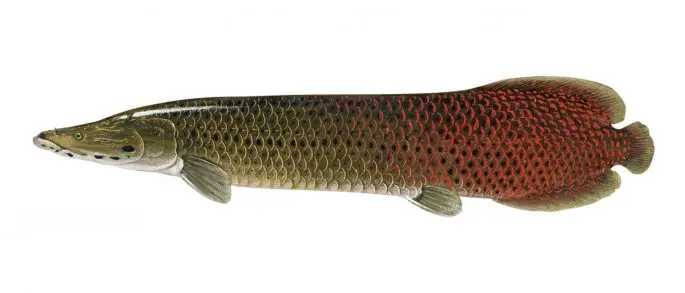
This large representative of tropical rivers and lakes is able to grow up to 2 meters in length, while there are individual species that grow up to 3 meters in length. Although the information has not been confirmed, but, according to eyewitnesses, there are individuals up to 5 meters long, and maybe more. A specimen was caught that weighed almost 200 kg. The body of the arapaima is elongated and strongly tapering closer to the head, while it is slightly flattened on the sides. The head is relatively small, but elongated.
The shape of the head skull is thickened from above, while the eyes are located closer to the lower part of the muzzle, and the relatively small mouth is located closer to the top. The arapaima has a fairly strong tail, which helps the fish jump high out of the water when the predator is chasing its prey. The body is covered over the entire surface with multi-layered scales, which are large in size, which creates a pronounced relief on the body. The predator’s head is protected by bone plates in the form of a unique pattern.
Interesting fact! The scales of arapaima are so strong that they are several times stronger than bone tissue. For this reason, fish are easily found in water bodies along with piranhas, who do not dare to attack her.
The pectoral fins of the fish are set low, almost in the belly area. The anal fin and dorsal fins are comparatively long and are closer to the caudal fin. Such an arrangement of fins allows the already powerful and strong fish to move quite quickly in the water column, catching up with any potential prey.
The front part of the body is distinguished by an olive-brown tint and a bluish tint, which gradually turns into a reddish tint in the area of unpaired fins, and acquires a dark red color at the level of the tail. In this case, the tail, as it were, is set off by a wide dark border. Gill covers may also have a reddish tint. This species has highly developed sexual dimorphism: males are distinguished by a more runaway and brightly colored body, but this is typical for sexually mature adults. Young individuals have almost the same and monotonous coloring, regardless of gender.
Behavior, lifestyle
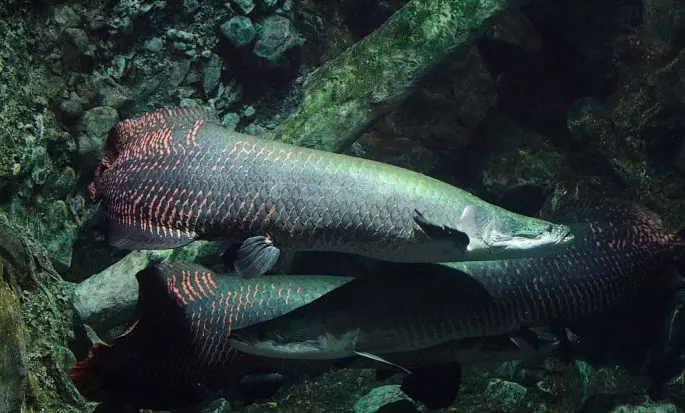
Arapaima leads a benthic lifestyle, but in the process of hunting it can rise to the upper layers of the water. Since this is a giant predator, it needs a lot of energy. In this regard, it should be noted that the arapaima is in constant motion, looking for food for itself. It is an active predator that does not hunt from cover. When an arapaima pursues its prey, it can jump out of the water to its full length, or even higher. Thanks to this opportunity, she can hunt not only fish, but also animals and birds that are within the reach of a predator.
Interesting information! The pharynx and swim bladder of a predator are pierced by a huge number of blood vessels, resembling cells in structure. This structure is comparable to the structure of lung tissue.
In this regard, we can safely assume that the arapaima has an alternative respiratory organ, which is very important in such difficult conditions of existence. In other words, this predator can also breathe air. Thanks to this phenomenon, fish easily survive dry periods.
As a rule, water bodies often become smaller in the tropics, as a result of the drought that replaces the rainy season, and significantly. Under such conditions, the arapaima burrows into moist silt or sand, but after a while it appears on the surface to swallow fresh air. As a rule, such throats are accompanied by significant noise that extends for tens or even hundreds of meters, if not kilometers.
Often this predator is kept in captivity, while the fish grows in such conditions up to one and a half meters, no more. Naturally, arapaima cannot be considered an ornamental, and even more so, an aquarium fish, although there are lovers who cope with many problems.
Arapaima can often be seen in zoos or aquariums, although keeping it in such conditions is not so easy, because it takes up a lot of space, and it is necessary to maintain the temperature at a comfortable level for the fish. This fish is quite thermophilic and it feels uncomfortable even when the temperature drops below the optimum, by a couple of degrees. And yet, some amateur aquarists keep this unique predator, more like a crocodile, but without limbs.
Catching a Monster. Giant Arapaima
How long does arapaima live
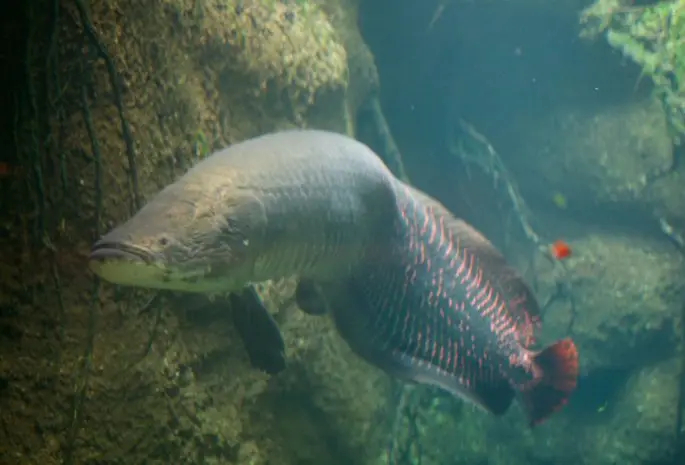
To date, there is no reliable information about how long the arapaima lives in the natural environment. At the same time, it is known how long these unique creatures can live in an artificial environment. Under favorable conditions, fish manage to live up to 20 years. Based on such data, it can be assumed that in natural conditions they can live as long, and maybe longer. As a rule, in artificial conditions, natural inhabitants live less.
natural habitats
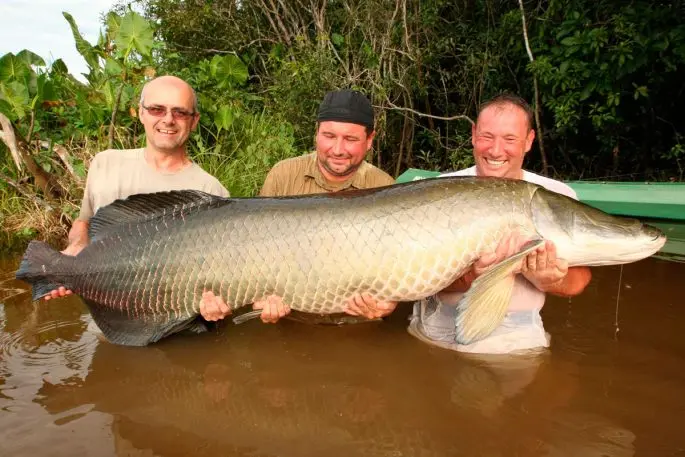
This unique living creature lives in the Amazon basin. In addition, the arapaima was artificially relocated to the water bodies of Thailand and Malaysia.
For their life, the fish chooses river backwaters, as well as lakes, in which a lot of aquatic vegetation grows. It can also be found in floodplain reservoirs, with water temperatures up to +28 degrees, or even more.
Interesting to know! During periods of seasonal rains, arapaima appears in flooded floodplain forests. As the water drains, it returns to rivers and lakes.
Diet

Arapaima is a rather voracious predator, the basis of the diet of which is fish of a suitable size. At the same time, the predator will not miss the chance so as not to attack gaping birds or small animals that have settled on the branches of trees or other vegetation.
As for the young individuals of the arapaima, they are no less voracious and absolutely illegible in food. They attack any living creature that is in their field of vision, even small snakes.
Interesting fact! The arapaima has a favorite dish, in the form of its distant relative aravana, which also represents a detachment of arabians.
In cases where this predator is kept in artificial conditions, it is given a very diverse food of animal origin. Arapaima, as a rule, hunt on the move, so small fish are always launched into the aquarium. For adults, one feeding per day is enough, and juveniles should eat at least 3 times a day. If this predator is not fed in a timely manner, then it is able to attack its relatives.
Reproduction and offspring

After reaching the age of five and a length of about one and a half meters, the females are ready to reproduce offspring. Spawning takes place either in February or March. The female lays eggs in a depression made at the bottom of the reservoir in advance, while the bottom must be sandy. Before the spawning process, she returns to the prepared place, which is a depression ranging in size from 50 to 80 cm, together with the male. The female lays rather large eggs, and the male fertilizes them. After a couple of days, fry appear from the eggs. All this time, from the moment of spawning, the parents guard the nest. The male is always nearby and feeds the fry. The female is also nearby, swimming away no more than a couple of tens of meters.
Interesting to know! After birth, the fry are constantly near the male. Near the eyes of the male there are special glands that secrete a special white substance that the fry feed on. In addition, the substance exudes a bright aroma that keeps fry close to the male.
The fry quickly gain weight and grow, adding monthly up to 5 cm in length and up to 100 grams in weight. After a week, you can notice that the fry are predators, as they begin to independently obtain food for themselves. At the initial stage of their development, their diet consists of zooplankton and small invertebrates. As they grow, young individuals begin to chase small fish and other food items of animal origin.
Despite such facts, parents continue to observe their offspring for 3 months. According to scientists, this fact is due to the fact that young individuals during this period do not have time to understand that they are able to breathe atmospheric air, and the task of parents is to teach them this possibility.
Natural enemies of arapaima

Due to the structural features of the body, the arapaima has practically no natural enemies. Since individuals, even young ones, have rather large and reliable scales, even piranhas cannot bite through it. There is evidence that alligators are able to attack this predator. But given that the arapaima is distinguished by its power and speed of movement, then alligators, most likely, can catch only sick and inactive, as well as careless individuals.
And yet this predator has a serious enemy – this is a person who thinks little about the future, but lives exclusively for one day.
Fishing value
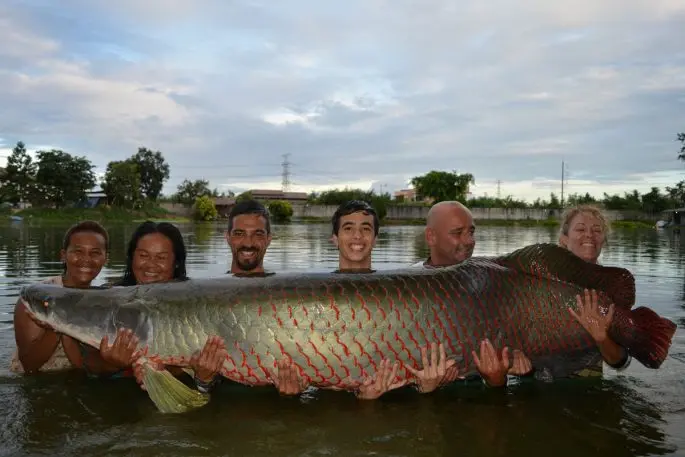
The Indians who inhabit the Amazon have survived for many centuries on the meat of the arapaima. The locals of South America called this fish “red fish” because its meat had a red-orange color, as well as the same marks on the body of the fish.
Interesting to know! The locals of the Amazon have been catching this fish for many centuries using a certain technique. To begin with, they tracked their prey by the characteristic sigh when the fish rose to the surface of the water to take a breath of fresh air. At the same time, the place where the fish rises to the surface is noticeable at a great distance. After that, they could kill the predator with a harpoon or catch it with nets.
Arapaima meat is characterized as tasty and nutritious, while even its bones are used today by connoisseurs of traditional Indian medicine. In addition, the bones are used to make household items, and the scales are used to make nail files. All these products are in great demand among foreign tourists. Fish meat is quite valuable, therefore it has a high cost in the markets of South America. Because of this, there is an official ban on catching this unique predator, which makes it no less valuable and more desirable trophy, especially for local anglers.
The BIGGEST Arapaima Jeremy Wade Has EVER Caught | ARAPAIMA | River Monsters
Population and species status
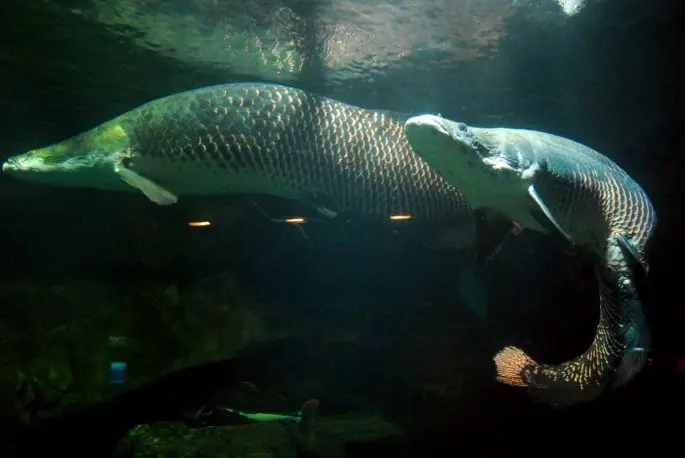
Over the past 100 years, the number of arapaima has declined markedly due to uncontrolled and systematic fishing, especially with nets. As a rule, the main hunting was carried out on large individuals, since size was of decisive importance. As a result of such ill-conceived human activity in the reservoirs of the Amazon, it is difficult to see individuals growing up to 2 meters in length, or even more. In some water areas, catching arapaima is prohibited at all, although these prohibitions are ignored by both local residents and poachers, although the Indians are not forbidden to catch this fish to feed themselves. And this is all due to the fact that this predator has quite valuable meat. If the arapaima were caught by the Indians, like their ancestors for many centuries, then there would be no problems, but the actions of poachers cause serious damage to the number of this unique fish.
And yet, the future of this unique fish interested some Brazilian farmers who wished to preserve the number of arapaima. They developed a methodology and received permission from the government to breed this species in an artificial environment. After that, they managed to catch a few individuals in the natural environment, and they moved them to artificially created reservoirs. As a result, the goal was set to saturate the market with meat of this species, grown in captivity, which should lead to a decrease in the volume of catch of arapaima in natural conditions.
Important information! To date, there is no exact data on the abundance of this species, and there is also no data on whether it is decreasing at all, which complicates the decision-making procedure. This fact is due to the fact that the fish lives in hard-to-reach places in the Amazon. In this regard, this species was assigned the status “Insufficient information”.
Arapaima is, on the one hand, a strange, and on the other hand, an amazing creature, which is a representative of the era of dinosaurs. At least that’s what scientists think. Judging by the facts, this tropical monster that inhabits the Amazon basin has practically no natural enemies. It would seem that the number of this unique predator should go off scale and a person should take measures to optimize this number at a certain level by carrying out planned catches. The picture is quite the opposite and a person has to take measures to preserve the number of this fish. Therefore, it is necessary to breed this predator in captivity. How successful these attempts will be, only time will tell.
In conclusion
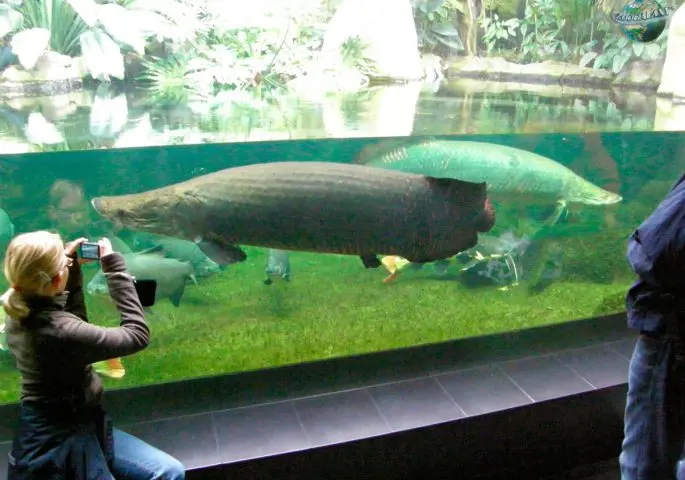
The Amazon is an amazing place on our planet and has not been fully explored so far. And all this is due to the fact that these are hard-to-reach places, although they do not stop poachers in any way. This factor leaves a significant imprint on the study of many species, including arapaima. Meeting natural giants in this part of the universe is a common occurrence. According to local fishermen, there were individuals up to 5 meters long, although in our time this is a rarity. In 1978, a specimen was caught in the Rio Negro, almost 2,5 meters long and weighing almost 150 kilograms.
For many centuries, arapaima meat has been the main source of food. Beginning in the 1960s, mass destruction of the species began: adults were killed with harpoons, and smaller ones were caught in nets. Despite official bans, this predator continues to be caught by both local fishermen and poachers. And this is not surprising, since 1 kg of arapaima meat on the world market costs more than the monthly salary of local fishermen. In addition, the taste of arapaima meat can only compete with the taste of salmon. These factors serve as the trigger that pushes people to break the law.
Epic Amazon River Monster









